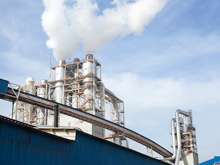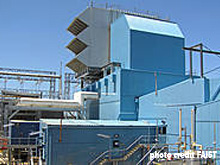Soundproofing for environmental protection is intended to preserve noise sources neighborhood from any noise pollution.
Road and rail infrastructure are examples of such noise sources that one must be guarded against, as the continuous rise in traffic leads to the increase of noise emissions and therefore of the likelihood of increased (negative) impact for residents.
Screens (noise barriers) are means of limiting the propagation of noise in (restricted) areas where the phenomenon of diffraction of sound waves occurs.
Industrial sites are another example of juxtaposition of sound sources to which we must act in order not to cause discomfort for the neighborhood, and for which the implementation of acoustic screens is sometimes performed (punctual, e.g. around and in the vicinity of air condensers or extended, in limit of property).
But we must not lose sight of the fact that "at the source" action, when it is possible, is often the most effective way of combating industrial noise, namely in a context of soundproofing for environmental protection.
When the acoustic quality of the building that houses them is not optimal, machines with a very high sound power level, such as printing presses, corrugated cardboard production lines, presses for the forming of metal or for building materials must be enclosed, through the use of a noise-limiting enclosure that includes all noisy components (workers protection may also be another reason for considering such soundproofing devices).
|
air intake system for a gas turbine |

discharge/vent silencer |
In the power generation sector, engines, gas turbines, compressors must be installed inside buildings whose ability to limit the transmission of sound is an essential feature, both in terms of current surfaces (walls, roofing) as regards the ventilation openings, some of which are equipped with ventilation systems which are themselves noisy; the operation of turbomachines in general, and in particular the air intake and the exhaust of a gas, burned or not, requires silencers, to be sized to operate, as the case may be, at room temperature, or else at low or high temperature, sometimes with a pressurized fluid, always with fluid velocities that constitute an obstacle to acoustic performance because of involved flow noise and of total pressure loss which is often the object of a limitation to the origin of complications.
Thus, shrouds, dissipative or reactive silencers, exhaust silencers are (in addition to anti-noise walls and buildings with high acoustic performance) equipment frequently used in the context of soundproofing action for environmental protection plans when it is a question of limiting the noise emissions, in particular in the context of Establishments Classified for Environmental Protection. (ECEP).
In France, such industrial plants are subject to specific regulatory constraints, particularly in terms of emergence i.e. the difference between the A-weighted equivalent continuous pressure levels of the ambient noise (establishment in operation) and the residual noise (without noise generated by the establishment, but measured over the period of operation of the establishment).In Zones with Regulated Emergence (ZREs), the allowable value of emergence depends on the level of ambient noise and the period under consideration.
| Ambiant noise level | Allowable emergence: period 7h - 22 h except Sundays & public holidays |
Allowable emergence: period 22h – 7h + Sundays & public holidays |
| Between 35 dB(A) et 45 dB(A) | 6 dB(A) | 4 dB(A) |
| Above 45 dB(A) | 5 dB(A) | 3 dB(A) |
Regulation, standards, measurements, calculations (impact, sizing), supply and installation of equipment for limiting noise emissions: ITS is an expert in the various aspects of soundproofing for environmental protection.
